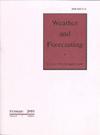Moving beyond the Aerosol Climatology of WRF-Solar: A Case Study over the North China Plain
IF 3
3区 地球科学
Q2 METEOROLOGY & ATMOSPHERIC SCIENCES
引用次数: 0
Abstract
Numerical weather prediction (NWP), when accessible, is a crucial input to short-term solar power forecasting. WRF-Solar, the first NWP model specifically designed for solar energy applications, has shown promising predictive capability. Nevertheless, few attempts have been made to investigate its performance under high aerosol loading, which attenuates incoming radiation significantly. The North China Plain is a polluted region due to industrialization, which constitutes a proper testbed for such investigation. In this paper, aerosol direct radiative effect (DRE) on three surface shortwave radiation components (i.e., global, beam, and diffuse) during five heavy pollution episodes is studied within the WRF-Solar framework. Results show that WRF-Solar overestimates instantaneous beam radiation up to 795.3 W m−2 when the aerosol DRE is not considered. Although such overestimation can be partially offset by an underestimation of the diffuse radiation of about 194.5 W m−2, the overestimation of the global radiation still reaches 160.2 W m−2. This undesirable bias can be reduced when WRF-Solar is powered by Copernicus Atmosphere Monitoring Service (CAMS) aerosol forecasts, which then translates to accuracy improvements in photovoltaic (PV) power forecasts. This work also compares the forecast performance of the CAMS-powered WRF-Solar with that of the European Centre for Medium-Range Weather Forecasts model. Under high aerosol loading conditions, the irradiance forecast accuracy generated by WRF-Solar increased by 53.2% and the PV power forecast accuracy increased by 6.8%. Numerical weather prediction (NWP) is the “go-to” approach for achieving high-performance day-ahead solar power forecasting. Integrating time-varying aerosol forecasts into NWP models effectively captures aerosol direct radiation effects, thereby enhancing the accuracy of solar irradiance forecasts in heavily polluted regions. This work not only quantifies the aerosol effects on global, beam, and diffuse irradiance but also reveals the physical mechanisms of irradiance-to-power conversion by constructing a model chain. Using the North China Plain as a testbed, the performance of WRF-Solar on solar power forecasting on five severe pollution days is analyzed. This version of WRF-Solar can outperform the European Centre for Medium-Range Weather Forecasts model, confirming the need for generating high spatial–temporal NWP.超越 WRF-Solar 的气溶胶气候学:华北平原案例研究
数值天气预报(NWP)是短期太阳能发电预测的重要输入。WRF-Solar 是首个专为太阳能应用而设计的 NWP 模型,已显示出良好的预测能力。然而,很少有人尝试研究其在高气溶胶负荷下的性能,因为高气溶胶负荷会显著衰减入射辐射。华北平原是由于工业化而造成污染的地区,这为此类研究提供了一个合适的试验平台。本文在 WRF-Solar 框架内研究了五次重污染天气过程中气溶胶对三种地表短波辐射成分(即全球、波束和漫射)的直接辐射效应(DRE)。结果表明,在不考虑气溶胶焚毁效应的情况下,WRF-Solar 对瞬时波束辐射的高估可达 795.3 W m-2。虽然这种高估可以通过低估约 194.5 W m-2 的漫射辐射来部分抵消,但对全球辐射的高估仍然达到 160.2 W m-2。当哥白尼大气监测服务(CAMS)气溶胶预报为 WRF-Solar 提供动力时,这种不理想的偏差就会减小,进而转化为光伏(PV)功率预报精度的提高。这项工作还比较了哥白尼大气监测服务(CAMS)驱动的 WRF-Solar 与欧洲中期天气预报中心模型的预报性能。在高气溶胶负荷条件下,WRF-Solar 生成的辐照度预测精度提高了 53.2%,光伏发电预测精度提高了 6.8%。将时变气溶胶预报纳入 NWP 模型可有效捕捉气溶胶的直接辐射效应,从而提高重污染地区的太阳辐照度预报精度。这项工作不仅量化了气溶胶对全球辐照度、光束辐照度和漫射辐照度的影响,还通过构建模型链揭示了辐照度-功率转换的物理机制。以华北平原为试验平台,分析了WRF-Solar在五个重污染日的太阳能预报性能。该版本的 WRF-Solar 性能优于欧洲中期天气预报中心模式,证实了生成高时空 NWP 的必要性。
本文章由计算机程序翻译,如有差异,请以英文原文为准。
求助全文
约1分钟内获得全文
求助全文
来源期刊

Weather and Forecasting
地学-气象与大气科学
CiteScore
5.20
自引率
17.20%
发文量
131
审稿时长
6-12 weeks
期刊介绍:
Weather and Forecasting (WAF) (ISSN: 0882-8156; eISSN: 1520-0434) publishes research that is relevant to operational forecasting. This includes papers on significant weather events, forecasting techniques, forecast verification, model parameterizations, data assimilation, model ensembles, statistical postprocessing techniques, the transfer of research results to the forecasting community, and the societal use and value of forecasts. The scope of WAF includes research relevant to forecast lead times ranging from short-term “nowcasts” through seasonal time scales out to approximately two years.
 求助内容:
求助内容: 应助结果提醒方式:
应助结果提醒方式:


